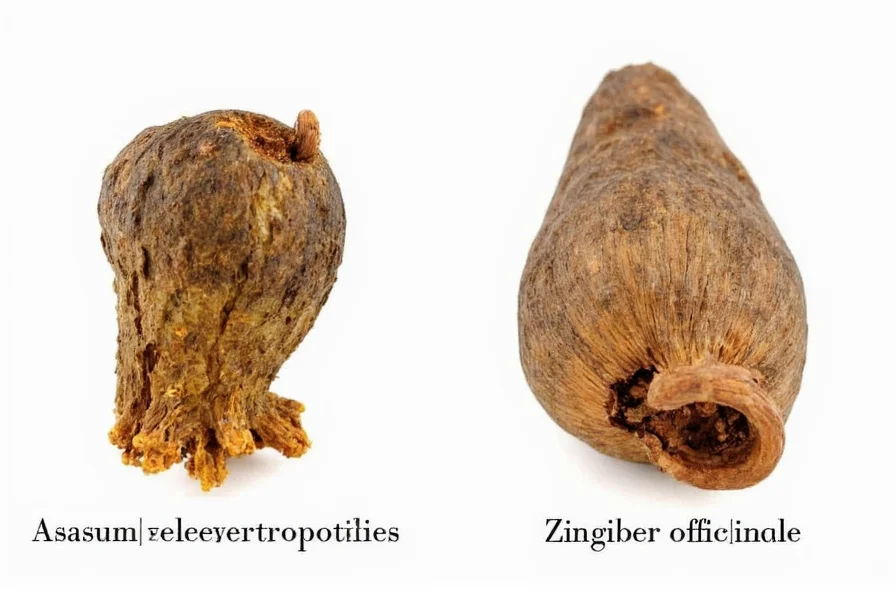Understanding the botanical reality of Chinese wild ginger is crucial for anyone exploring traditional herbal remedies. The term "Chinese wild ginger" creates significant confusion because it bears no close botanical relationship to the ginger (Zingiber officinale) found in grocery stores. This misnomer has dangerous implications, as several Asarum species contain aristolochic acids—compounds now recognized as nephrotoxic and carcinogenic.
Botanical Identification and Nomenclature
Chinese wild ginger encompasses several species within the Asarum genus, primarily Asarum heterotropoides (known as xi xin in traditional Chinese medicine). These plants belong to the Aristolochiaceae family, completely separate from Zingiberaceae, the family containing culinary ginger. The visual similarity of their creeping growth habit and underground rhizomes led to the misleading common name.
Key identifying characteristics include:
- Low-growing perennial with heart-shaped leaves
- Small, bell-shaped flowers growing close to the ground
- Rhizomes with a distinctive aroma (though not identical to culinary ginger)
- Native to forested regions of China, Korea, and Japan
Traditional Uses in Chinese Medicine
For centuries, certain Asarum species have been used in traditional Chinese medicine formulations, primarily for respiratory conditions, toothaches, and as an analgesic. The rhizomes were typically dried and processed before use. Historical texts document its application for "dispelling cold" and "relieving pain," often in combination with other herbs.
However, traditional use doesn't equate to safety by modern scientific standards. Ancient practitioners lacked understanding of the biochemical mechanisms that we now recognize as problematic. The traditional preparation methods may have reduced but not eliminated the toxic compounds present in these plants.
Safety Concerns and Scientific Evidence
The most significant concern regarding Chinese wild ginger is its aristolochic acid content. Research published in the Journal of the National Cancer Institute established a clear link between aristolochic acid exposure and upper urinary tract cancer. Additional studies have documented cases of aristolochic acid nephropathy (AAN), a progressive kidney disease.
| Plant Type | Scientific Name | Family | Key Compounds | Safety Status |
|---|---|---|---|---|
| Chinese Wild Ginger | Asarum heterotropoides | Aristolochiaceae | Aristolochic acids | Banned in many countries |
| Culinary Ginger | Zingiber officinale | Zingiberaceae | Gingerols, shogaols | Generally recognized as safe |
Regulatory agencies worldwide have taken action based on this evidence. The U.S. Food and Drug Administration issued warnings about aristolochic acid-containing products, while the European Medicines Agency recommends against their use. China's National Medical Products Administration has restricted the use of Asarum species in herbal formulations.
Differentiation from Culinary Ginger
The confusion between Chinese wild ginger and culinary ginger represents a serious public health concern. Many consumers mistakenly believe they're acquiring the edible ginger when purchasing "wild ginger" products. This misunderstanding has led to documented cases of poisoning.
Key differences include:
- Botanical family: Asarum (Aristolochiaceae) vs. Zingiber (Zingiberaceae)
- Active compounds: Aristolochic acids (toxic) vs. gingerols (generally safe)
- Traditional preparation: Requires specific processing vs. direct culinary use
- Regulatory status: Restricted/banned vs. widely available
Responsible Considerations for Herbal Practice
For those interested in traditional herbal medicine, understanding the distinction between these plants is non-negotiable. Reputable practitioners of traditional Chinese medicine now use alternative herbs to replace Asarum species in formulations. Modern TCM practice increasingly incorporates scientific safety data alongside traditional knowledge.
If exploring herbal remedies, always:
- Verify the exact botanical name of any herb
- Consult healthcare professionals knowledgeable in both conventional and herbal medicine
- Source herbs from reputable suppliers who provide proper identification
- Be wary of products using ambiguous common names

Conclusion
Chinese wild ginger (Asarum species) represents a cautionary tale about the intersection of traditional medicine and modern scientific understanding. While historically significant in certain traditional practices, contemporary research has revealed serious safety concerns that cannot be ignored. The critical distinction between these plants and culinary ginger must be understood to prevent accidental exposure to toxic compounds. As herbal medicine continues to gain popularity globally, accurate botanical identification and awareness of potential risks remain essential for safe practice.
Frequently Asked Questions
Is Chinese wild ginger the same as the ginger I use in cooking?
No, Chinese wild ginger (primarily Asarum heterotropoides) is completely different from culinary ginger (Zingiber officinale). They belong to separate plant families, contain different chemical compounds, and have vastly different safety profiles. Culinary ginger is safe for consumption while many Chinese wild ginger species contain toxic aristolochic acids.
What are the specific health risks associated with Chinese wild ginger?
Chinese wild ginger containing aristolochic acids has been linked to aristolochic acid nephropathy (permanent kidney damage) and upper urinary tract cancers. The U.S. National Toxicology Program classifies aristolochic acids as known human carcinogens. Even limited exposure may pose significant health risks, particularly with repeated use.
Why was Chinese wild ginger used historically if it's dangerous?
Traditional practitioners lacked modern analytical methods to identify specific toxic compounds. Historical use was based on observed effects without understanding underlying mechanisms. Some traditional preparation methods may have reduced but not eliminated toxins. Modern scientific analysis has revealed risks that weren't apparent through traditional observation alone.
Are there safe alternatives to Chinese wild ginger in traditional medicine?
Yes, many traditional Chinese medicine practitioners now use safer alternatives such as Schisandra chinensis (wu wei zi) or Magnolia officinalis (hou po) in formulations that previously contained Asarum species. Reputable TCM practitioners are aware of the safety concerns and have adapted their practice accordingly.










 浙公网安备
33010002000092号
浙公网安备
33010002000092号 浙B2-20120091-4
浙B2-20120091-4